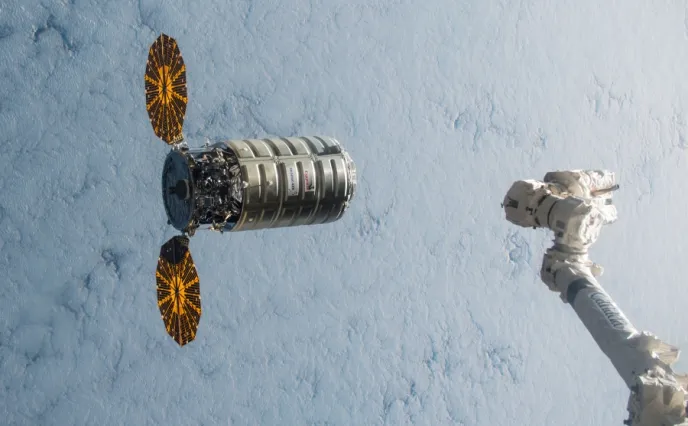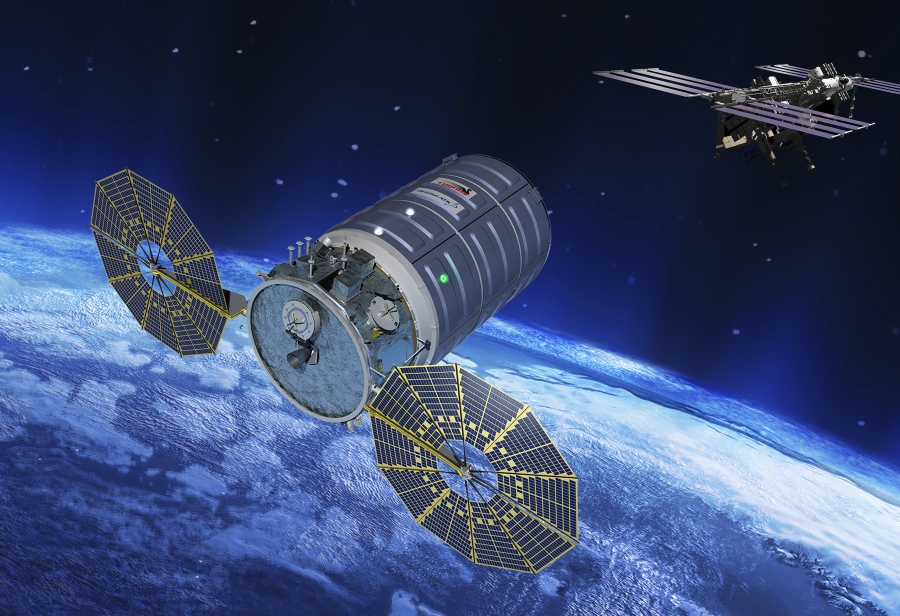In the Spotlight
Cygnus 5: mission accomplished!

After delivering more than 7,000 pounds of supplies to the International Space Station, the Cygnus 5 spacecraft, dubbed the SS Deke Slayton II in honor of the late Mercury 7 astronaut, will complete its mission on Friday, Feb. 19.
The Cygnus spacecraft arrived at the station on December 9, unloaded its supplies and gradually took on some 3,000 pounds of trash. It will now be detached from the Earth-facing side of the Unity module using the Canadarm2 robotic arm, operated by ground controllers at NASA's Johnson Space Center in Houston. NASA’s Mission Control Center will maneuver Cygnus into place and astronauts Scott Kelly and Tim Kopra will give the command for its 7:25 a.m. EST release (1:25 pm Paris Time).
Once Cygnus is a safe distance from the station, its engines will fire twice, sending it back into the Earth's atmosphere, for a controlled burn-up over the Pacific Ocean

The Cygnus 5 mission began with a launch from Cape Canaveral, Florida on December 6, 2015.
At the International Space Station, the pressurized cargo module (PCM) developed by Thales Alenia Space on behalf of Orbital ATK, was captured by the Canadarm2 robotic arm and docked to the station’s Unity module. This operation was coordinated by the NASA astronaut Kjell Lindgren, with the ISS at an altitude of 400 km. This was the first mission with the advanced configuration PCM, which increased payload capacity to 3,508 kg (7,717 lb). It delivered crew supplies, spare parts and scientific equipment, in particular the first European spaceborne 3D printer, for an ISS demonstration to produce spare parts and equipment. More info about the onboard 3D printer’s successful mission.
The next Cygnus resupply mission is slated for March 22, using an Atlas V rocket. Stay tuned for further details!

Thales Alenia Space is a major contributor to the International Space Station (ISS). It is responsible for over half of its pressurized volume, and also played a major role on the ATV (Automated Transfer Vehicle) cargo vessels for ESA and on NASA's Cygnus spacecraft, which also ferry supplies to the ISS. Thales Alenia Space has leveraged its unrivaled expertise in orbital infrastructures and space transport to meet new challenges, including the IXV reentry demonstrator for ESA, and the pressurized compartment on SOAR (Sub-Orbital Aircraft Reusable), which will carry both scientific experiments and astronauts. Thales Alenia Space is also a leading contributor to the Orion Multi-Purpose Crew Vehicle (MPCV) being developed by NASA.
The Cygnus spacecraft arrived at the station on December 9, unloaded its supplies and gradually took on some 3,000 pounds of trash. It will now be detached from the Earth-facing side of the Unity module using the Canadarm2 robotic arm, operated by ground controllers at NASA's Johnson Space Center in Houston. NASA’s Mission Control Center will maneuver Cygnus into place and astronauts Scott Kelly and Tim Kopra will give the command for its 7:25 a.m. EST release (1:25 pm Paris Time).
Once Cygnus is a safe distance from the station, its engines will fire twice, sending it back into the Earth's atmosphere, for a controlled burn-up over the Pacific Ocean
The mission

The Cygnus 5 mission began with a launch from Cape Canaveral, Florida on December 6, 2015.
At the International Space Station, the pressurized cargo module (PCM) developed by Thales Alenia Space on behalf of Orbital ATK, was captured by the Canadarm2 robotic arm and docked to the station’s Unity module. This operation was coordinated by the NASA astronaut Kjell Lindgren, with the ISS at an altitude of 400 km. This was the first mission with the advanced configuration PCM, which increased payload capacity to 3,508 kg (7,717 lb). It delivered crew supplies, spare parts and scientific equipment, in particular the first European spaceborne 3D printer, for an ISS demonstration to produce spare parts and equipment. More info about the onboard 3D printer’s successful mission.
The next Cygnus resupply mission is slated for March 22, using an Atlas V rocket. Stay tuned for further details!
Orbital infrastructure and space transport

Thales Alenia Space is a major contributor to the International Space Station (ISS). It is responsible for over half of its pressurized volume, and also played a major role on the ATV (Automated Transfer Vehicle) cargo vessels for ESA and on NASA's Cygnus spacecraft, which also ferry supplies to the ISS. Thales Alenia Space has leveraged its unrivaled expertise in orbital infrastructures and space transport to meet new challenges, including the IXV reentry demonstrator for ESA, and the pressurized compartment on SOAR (Sub-Orbital Aircraft Reusable), which will carry both scientific experiments and astronauts. Thales Alenia Space is also a leading contributor to the Orion Multi-Purpose Crew Vehicle (MPCV) being developed by NASA.

